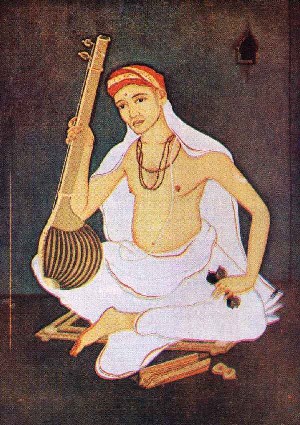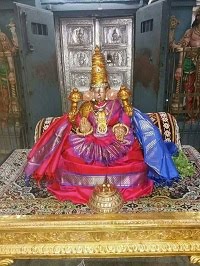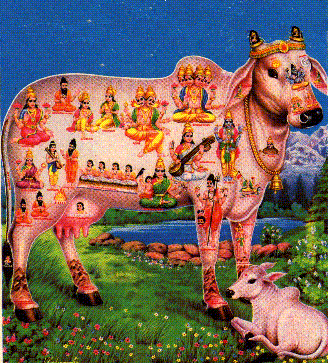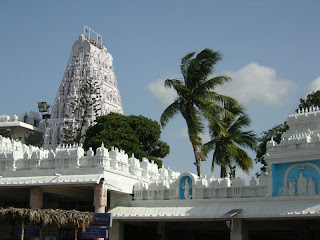
SEARCH
THIS WEEK'S BHAKTILAHARI POPULAR POSTS
-
MANGALA HARATHI OF LORD SHIVA శివ మంగళ హారతి భవాని చంద్రశేఖరాయ శంకరాయ మంగళం గౌరినిత్య తరంగాయ ఈశ్వరాయ మంగళం పారిజాత శోబితాయ పావనాయ మం...
-
అభీష్ట సిద్ధిరస్తు అత్యంత అనుకూల దాంపత్య సుఖ ప్రాప్తిరస్తు చిరంజీవ చిరంజీవ సుఖీభవ సుఖీభవ ధీర్గయుష్మాన్ భవ ధీర్గసుమంగళి భవ మాంగల్యగ...
-
What is Pradakshinam and How it should be performed? Pradakshinam is one of the Shodashopacharas (16 ways of worshipping god). As per pura...
-
Puttaparthy saibaba baba 84th birthday special
-
Importance of chanting Vishnu Sahasranamam Every person has a Slokam from Vishnu Sahasranama Sthothram, based on his or her birth star a...
Thursday, November 1, 2007
Wednesday, October 24, 2007
Monday, October 15, 2007
Friday, October 12, 2007
Legend of Navratri
There are many myths and legends attached to the Navratras. According to North Indian stories, Mahishasura, the mighty demon with the power to change into a buffalo obtained a boon from Lord Brahma that he could not be killed by any man in the world. Puffed up by the protection of the boon, he Mahishasura set out to conquer the three worlds of heaven, earth and hell and drove away Indra and other deities from their kingdom. To protect the world from his atrocities the trinity of Brahma, Vishnu and Shiva united their powers to give birth to a female warrior-goddess Durga. Dazzled by the divine beauty, Mahishasura proposed the Goddess for marriage but was instead challenged to a duel that went on for nine days and nights and at last, resulted in the beheading of Mahisa on the tenth. The nine nights came to be known as Navratri, while the tenth day was called vijaya dashami, the tenth day that brought the triumph of good over the evil.
In East India, however, the legends suggest that Daksha, the king of the Himalayas had a beautiful and virtuous daughter called Uma, who wished to marry Lord Shiva since her childhood. However, when Shiva finally came to marry her, the tiger-skin clad groom displeased Daksha and he broke off all the relationships with his daugher and son-in-law. The events took such a turn that Uma was so incensed of her father's rude behavior that she immolated herself to the great grief of Lord Shiva. However, she took re-birth and again won Shiva as her groom and peace was restored. It is believed that since then Uma comes every year with her four children Ganesh, Kartik, Saraswati and Laxmi and two of her best friends or 'sakhis' called Jaya and Bijaya, to visit her parent's home during Navratri. These legends and story are part of the history that surrounds the festival of Navratri and are going to be around as long as the festival continues.
In East India, however, the legends suggest that Daksha, the king of the Himalayas had a beautiful and virtuous daughter called Uma, who wished to marry Lord Shiva since her childhood. However, when Shiva finally came to marry her, the tiger-skin clad groom displeased Daksha and he broke off all the relationships with his daugher and son-in-law. The events took such a turn that Uma was so incensed of her father's rude behavior that she immolated herself to the great grief of Lord Shiva. However, she took re-birth and again won Shiva as her groom and peace was restored. It is believed that since then Uma comes every year with her four children Ganesh, Kartik, Saraswati and Laxmi and two of her best friends or 'sakhis' called Jaya and Bijaya, to visit her parent's home during Navratri. These legends and story are part of the history that surrounds the festival of Navratri and are going to be around as long as the festival continues.
Navaratri - Festival of Nine Nights

Navaratri is popularly known as Durga Puja in Bengal. In brief, the nine nights are dedicated to the three main goddesses of Hinduism - Parvati, Lakshmi and Sarasvati. After these nine days comes the Dashami, the tenth day, which is the day of the famous festival of Dussehra or Vijaya Dashami (the tenth day of victory ). This is the day Lord Rama had killed Ravana, signifying the victory of good over evil. Vaishnavas generally being absorbed in Vijay Dashami rather than Durga puja.
The total period of worship lasts for nine days out of which the first three are dedicated to Durga ( the Goddess of Valor ), the next three to Lakshmi ( the Goddess of Wealth ) and the last three to Saraswati ( the Goddess of Knowledge ). The Deity images of Them are created, worshipped and immersed in a sea or lake.
In Gujarat, Garbha dance is performed. In the South, houses are decorated and toys by the name of bommala koluvu (Bomma Kolam) are displayed. Durga has 1008 names or epithets but is worshipped in her nine forms which are sometimes interchangeable since basically they represent only her.
The following are the most popular forms of the goddess under which she is worshipped: Durga, goddess beyond reach; Bhadrakali, the Auspicious Power of Time; Amba or Jagadamba, Mother of the World; Annapurna, Giver of Food and Plenty; Sarvamangala, Auspicious Goddess; Bhairavi, Terrible, Fearful, Power of Death; Chandika or Chandi, Violent, Wrath, Fury; Lalita, Playfulness Personified; Bhavani, the Giver of Existence.
Navratri, is celebrated as the festival of nine nights, and is celebrated differently in different parts of India. In Gujarat, for nine nights, women and girls decked in finery, dance the garba around an earthen lamp or a kalash (pitcher) symbol of divine power, which is decorated with flowers and betal leaves, and has its mouth covered with a coconut. They sing and dance, clapping their hands in rhythmic movements, or do the Dandi dance (stick dance), holding two sticks and striking them to the rhyth, of the music.
In Tamil Nadu, the first three days of the festival are dedicated to Lakshmi, Goddess of Beauty and Prosperity; the next three days to Durga, Goddess of Righteousness, and the last three days to Saraswati, Goddess of Music and Learning. These goddesses are the consorts of Vishnu, Shiva and Brahma respectively. A special platform is decorated with the clay figurines of these gods and goddesses. The main room of worship contains a pitcher made of clay, silver or copper, depending on the devotee’s financial standing. The pitcher is placed in the centre of the room, its mouth covered with a cocnut and it is worshipped symbolically as Durga. Girls sing and dance before it and in the evening, gifts are exchanged.
In Andhra Pradesh the temple in the house is decorated with clay images of the Deities. A special sweetmeat like laddoos or sweet rice coloured yellow with turmeric, or khir (milk-preparation cooked in rice) is made eve3ry day and after offering to the household gods, is eaten. Everyone wears new clothes and friends drop in to see the family’s collection of images.
In Maharastra on the first day of navaratri the idol of Yogeshvari, a benign form of Durga, is installed in the house and the Haldi-Kum kum ceremony is held. Haldi (turmeric) and kum kum (vermilion) is applied on the forehead and sandalwood paste is smeared on the arms of all the invitees as these are considered auspicious.
In Maharastra on the first day of navaratri the idol of Yogeshvari, a benign form of Durga, is installed in the house and the Haldi-Kum kum ceremony is held. Haldi (turmeric) and kum kum (vermilion) is applied on the forehead and sandalwood paste is smeared on the arms of all the invitees as these are considered auspicious.
Each night (ratri) of Navratri is dedicated to one form of Goddess Durga. That is, every night (ratri) of Navratri corresponds to worship of different forms of Goddess Durga.
Maa Shailputri: The daughter of Parvatraj Himalaya (King of the Mountain Himalaya). She married Lord Shiva and is known as mother of Lord Ganesha (The Remover of obstacles) and Kartikeya (The God of War).
Maa Brahmachaarin: She gives the message of pure love to the world.
Maa Chandraghanta: She establishes Justice. She wears the crescent moon on her head.
Maa Kushmaanda: She provides the basic necessities and everyday sustenance to the world.
Skand Maa: She gives the gift of differentiation & discrimination of right from wrong to the world.
Maa Kaatyayini: She persistently & relentlessly battles against the evil, deceitful and devious entities.
Maa Kaalratri: She killed Raktabeeja (A demon who had the power to produce a demon from every drop of blood that fell from his body. Goddess & Divine Mother eventually licked the blood before it could reach the ground and hence conquered and overpowered him).
Maa Chaamunda: She killed two demons - Chanda and Munda and restored tranquility and order in the world. Maa MahaGauri: She also liberated the world from the evil forces.
Mata Sidhidaarti: She is a treasure house of Mystic Powers (Yantra Tantra) and Knowledge (Gyaan).
It is also said that the nine days are divided and devoted to the Trinity of God worshipped in a female form in which for three days Maa Durga (Goddess of valor, power and energy) is worshipped, for three days Maa Lakshmi (Goddess of wealth and prosperity) is worshipped and for three days for Maa Saraswati (Goddess of knowledge, learning and art) is worshipped.
The following rituals are observed in these nine days:
Rituals for the First Three Days of Navratris:
During the first three days of Navratri Maa Durga – (The Goddess of Valor, Power and Energy) is worshiped in her manifestations as Kumari, Parvati and Kali. These three forms represent the various stages of a woman - as a young virgin girl, as a wife and mother and as an old mature woman respectively. On the first day of Navratri, barley seeds are sown in a small pot (mostly an earthen pot or container) in the Puja (worship) room. On the tenth day, when these seeds grow into small shoots, these are pulled out and given to devotees as a blessing from god and are received as Prasad.
Rituals for Fourth - Sixth Days of Navratris :
During these three days, it is Maa Lakshmi – (The Goddess of wealth and prosperity) who is worshiped. This is done to rekindle divine qualities in a devotee’s mind. Prayers, Kirtans and Jagratns are organized in various temples and community halls by religious-minded people. On the fifth day, which is known as Lalita Panchami, it is traditional to gather and display all literature available in the house, light a lamp or 'diya' to invoke Saraswati Maa, the Goddess of knowledge and art.
Rituals for Seventh - Eighth Days of Navratris :
On the seventh and eighth day of Navratri, Maa Saraswati – (The Hindu Goddess of knowledge, learning and art) is worshiped. It is believed that worshiping Maa Saraswati enhances the spiritual knowledge of a devotee and makes a person free of all bonds of the Sansara (Material World). This in turn will free a devotee from all earthly bondages. On the 8th day of this colorful festival, Yagna or Homam (holy fire) is performed. Pure Desi Ghee (clarified pure butter), kheer (rice pudding) and sesame seeds form the holy offering to Goddess Durga Maa (Divine Mother). Many people in north India worship the 8th day as ashtami.
Rituals of the Ninth or Mahanavami Day:
The festival of Navratri culminates on Mahanavami. This is the most important day of the festival. On this day, 'Kanya Pujan' is performed in Hindu households. Nine young girls representing the nine forms of Goddess Durga are worshiped. Their feet are washed and then they are offered new clothes as gifts by the worshiper. They are also treated with a Prasad of Puri, Black Chanas (Chhole) and Halwa, small token of money, red bangles and a red scarf. On this day, these little girls usually move from house to house and enjoy and relish this special treat. This ritual is performed in most parts of the country.
During these Navratri days most of the people eat vegetarian food, some people eat food without any form of cereal and some fast for all the eight days.
In West Bengal, during Navratris, Goddess Durga is worshipped. The pujas are held over a five-day period, which is viewed as the homecoming of the married daughter, Durga, to her father, Parvatraj Himalaya’s ( Mountain King Himalaya) home. It is considered to be the most important festival of the Bengali people. During these days Bengali people buy new clothes, exchange sweets and make most of the new purchases. The new clothes that they buy are worn by them in the evenings when the family goes out to see the ‘Pandals’ (temporary structures set up to venerate the goddess Durga). Muscial evenings are mostly organized in these pandals. On the last day of the puja, the idol of the Goddess is taken with great fanfare and immersed in the river.
Thursday, October 11, 2007
Thyagaraya Kruthi - nagumomu

Thyagaraya Kruthi from Vissa TV 'Sankeeerthana' sung by Shilpa Deepika
Nagumomu
Thursday, October 4, 2007
Tuesday, October 2, 2007
Monday, October 1, 2007
Thursday, September 27, 2007
Tuesday, September 25, 2007
Tuesday, September 18, 2007
Monday, September 17, 2007
Wednesday, September 12, 2007
Monday, September 10, 2007
Sunday, September 2, 2007
Friday, August 31, 2007
Thursday, August 30, 2007
Shirdi Sai Baba Kakad Arathi
source youtube
Shirdi Sai Baba Kakad Arathi 1
Shirdi Sai Baba Kakad Arathi 2
Shirdi Sai Baba Kakad Arathi 3
Shirdi Sai Baba Kakad Arathi 4
Shirdi Sai Baba Kakad Arathi 1
Shirdi Sai Baba Kakad Arathi 2
Shirdi Sai Baba Kakad Arathi 3
Shirdi Sai Baba Kakad Arathi 4
Subscribe to:
Posts (Atom)





 Amma Sri Karunamayi sings a beautiful bhajan to Lord Sri Ganesha
Amma Sri Karunamayi sings a beautiful bhajan to Lord Sri Ganesha




 The Lost Temples of India
The Lost Temples of India